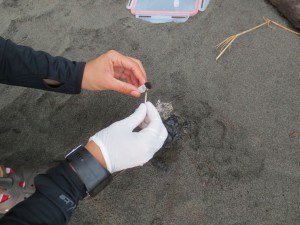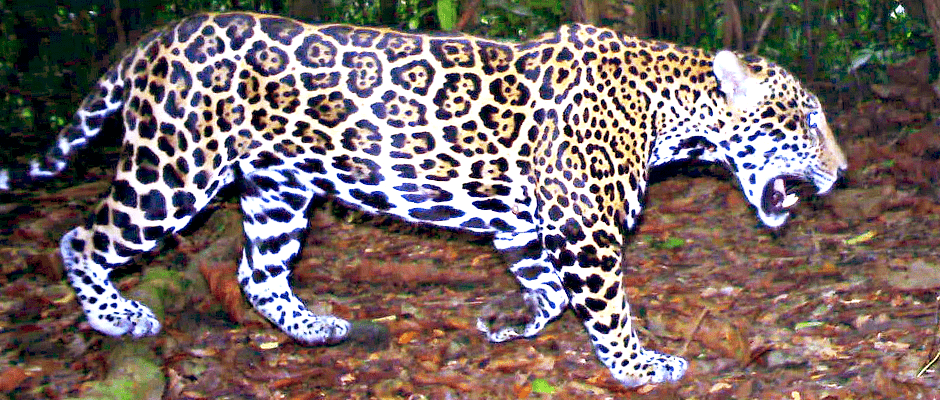Share this article
Scat: The first step in conserving Mesoamerican jaguars
Rare and elusive wildlife species such as jaguars can be tricky to study in the wild, especially when it comes to genetics. But noninvasive scat sampling has allowed researchers to conduct the first regional-scale genetic study of wild jaguar populations in Mesoamerica, where the cats have been extirpated from over 70 percent of their historic range.
“We are concerned about genetic connectivity [of jaguars] across the landscape,” said Claudia Wultsch, a postdoctoral research fellow with the American Museum of Natural History and Panthera, and a TWS member. She has been studying jaguars since 2006 when she started her Ph.D. research on Neotropical felids in Belize, applying noninvasive monitoring methods such as remote camera traps and felid scat surveys using professionally trained scat detector dogs. Analysis of scat samples enables researchers to assess genetic health and gene flow between natural jaguar populations across the fragmented Mesoamerican landscape and beyond.

Collecting jaguar scat at Tortuguero National Park, Costa Rica. ©Stephanny Arroyo-Arce
Wultsch and her coauthors were right to be concerned. Although overall genetic diversity of jaguars was moderate across five Mesoamerican countries—Belize, Costa Rica, Guatemala, Honduras and Mexico—they identified some areas of particular conservation concern. The Sierra Madre Oriental jaguars in northeastern Mexico had the lowest genetic diversity of any population in the study, and even displayed moderate levels of inbreeding. Right behind them were jaguars in Honduras, where habitat loss and fragmentation in the northern and central parts of the country could be reducing population sizes and increasing isolation of remaining populations.
With some of the highest deforestation rates worldwide, jaguars are losing critical habitat and are more exposed to human-wildlife conflict. Shipping corridors such as the Panama Canal and the current construction of a similar waterway in Nicaragua pose further threats to connectivity of Central American wildlife such as wide-ranging jaguars. According to Wultsch, gathering this genetic data on wild jaguar populations across Mesoamerica is a large international, cross-institutional research effort. Such efforts make regional monitoring of wild jaguars possible, which is the first step in solving the connectivity puzzle.
“[By analyzing fecal DNA] we can measure gene flow which indirectly gives us and idea if animals are actually moving throughout the landscape,” she said, noting that this is a very powerful way to measure connectivity and is instrumental for large-scale conservation strategies such as Panthera’s Jaguar Corridor Initiative and the Mesoamerican Biological Corridor.
Most concerning was the genetic subdivision found between two critically important areas of conservation for jaguars—the tri-national Selva Maya, or Maya Forest, and the Río Plátano Biosphere Reserve in southern Honduras. The Selva Maya spans across protected areas of southern Mexico, northern Guatemala, and central Belize, and the Río Plátano is part of La Moskitia, one of the largest wilderness area in Central America. The study suggests limited jaguar movement between these two areas despite close geographic proximity contradicting the hypothesis of contemporary panmixia (i.e. random mating within a breeding population). The region is facing rapid land cover changes and high deforestation rates, putting remaining “stepping stone” habitats and wildlife corridors at further risk, Wultsch says.
“Jaguars are generally forest dependent, but not always,” Wultsch said, noting that jaguars occur in a wide variety of habitat types but try to avoid human activity and human disturbance. They are often closely associated with water and feed on a variety of different prey species. Factors such as human activity, habitat type, water, prey and competition impact jaguar movement to some degree, Wultsch says, and should be considered when managing and restoring connectivity. Further interdisciplinary research on the multi-faceted drivers impacting jaguar movement will ultimately help improve management efforts to ensure critical linkage for dispersal and long-term viability for the species.
Wultsch’s jaguar research was among the first to test and optimize scat collection using professionally trained scat detector dogs and fecal DNA storage techniques in tropical environments. The research has helped establish fecal sampling as the go-to method for genetic surveys challenging tropical regions, where DNA samples degrade quickly in the warm, humid climate. Although the study is a groundbreaking step for jaguar conservation and management in Mesoamerica, it emphasizes the need for more scat surveys to fill data gaps in places like Nicaragua, Guatemala and Panama.
Genetic surveys and on-the-ground conservation efforts will continue. Educating the public and mitigating human-wildlife conflict are essential pieces of jaguar conservation. Currently Wultsch and others are working with several jaguar researchers across Belize, Guatemala and Honduras to connect genetic data with landscape data. They are studying how different natural and anthropogenic landscape features impact gene flow. Based on that research they will prioritize on-the-ground conservation and management efforts.
Header Image: Remote camera trap photo of male jaguar at Pico Bonito National Park, Honduras. ©Panthera-ICF








